sensor KIA Magnetis 2007 2.G Owner's Manual
[x] Cancel search | Manufacturer: KIA, Model Year: 2007, Model line: Magnetis, Model: KIA Magnetis 2007 2.GPages: 294, PDF Size: 3.37 MB
Page 37 of 294
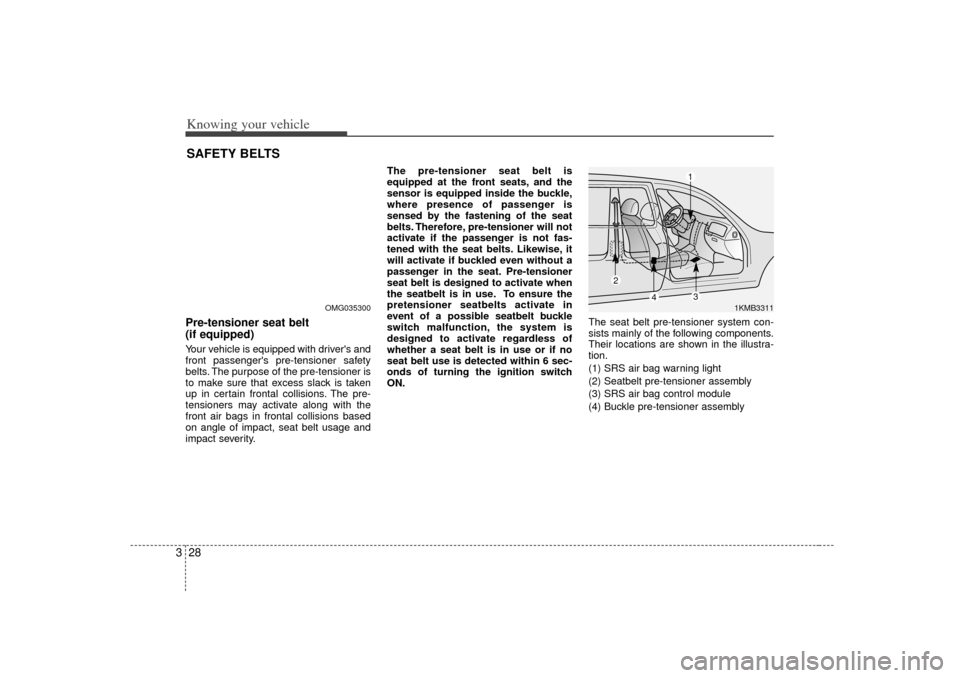
Knowing your vehicle28
3Pre-tensioner seat belt
(if equipped)Your vehicle is equipped with driver's and
front passenger's pre-tensioner safety
belts. The purpose of the pre-tensioner is
to make sure that excess slack is taken
up in certain frontal collisions. The pre-
tensioners may activate along with the
front air bags in frontal collisions based
on angle of impact, seat belt usage and
impact severity. The pre-tensioner seat belt is
equipped at the front seats, and the
sensor is equipped inside the buckle,
where presence of passenger is
sensed by the fastening of the seat
belts. Therefore, pre-tensioner will not
activate if the passenger is not fas-
tened with the seat belts. Likewise, it
will activate if buckled even without a
passenger in the seat. Pre-tensioner
seat belt is designed to activate when
the seatbelt is in use. To ensure the
pretensioner seatbelts activate in
event of a possible seatbelt buckle
switch malfunction, the system is
designed to activate regardless of
whether a seat belt is in use or if no
seat belt use is detected within 6 sec-
onds of turning the ignition switch
ON.
The seat belt pre-tensioner system con-
sists mainly of the following components.
Their locations are shown in the illustra-
tion.
(1) SRS air bag warning light
(2) Seatbelt pre-tensioner assembly
(3) SRS air bag control module
(4) Buckle pre-tensioner assemblySAFETY BELTS
1KMB3311
1
2
3
4
OMG035300
Page 57 of 294
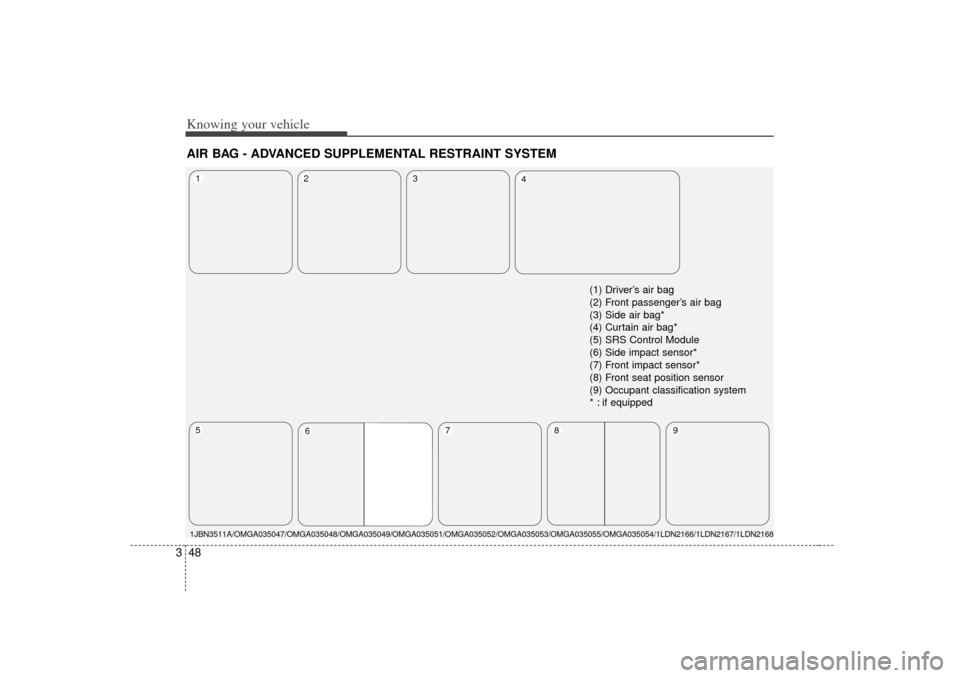
Knowing your vehicle48
3AIR BAG - ADVANCED SUPPLEMENTAL RESTRAINT SYSTEM 1JBN3511A/OMGA035047/OMGA035048/OMGA035049/OMGA035051/OMGA035052/OMGA035\
053/OMGA035055/OMGA035054/1LDN2166/1LDN2167/1LDN21681
2
3
5
4
7
(1) Driver’ s air bag
(2) Front passenger ’s air bag
(3) Side air bag*
(4) Curtain air bag*
(5) SRS Control Module
(6) Side impact sensor*
(7) Front impact sensor*
(8) Front seat position sensor
(9) Occupant classification system
* : if equipped
9
8
6
Page 59 of 294
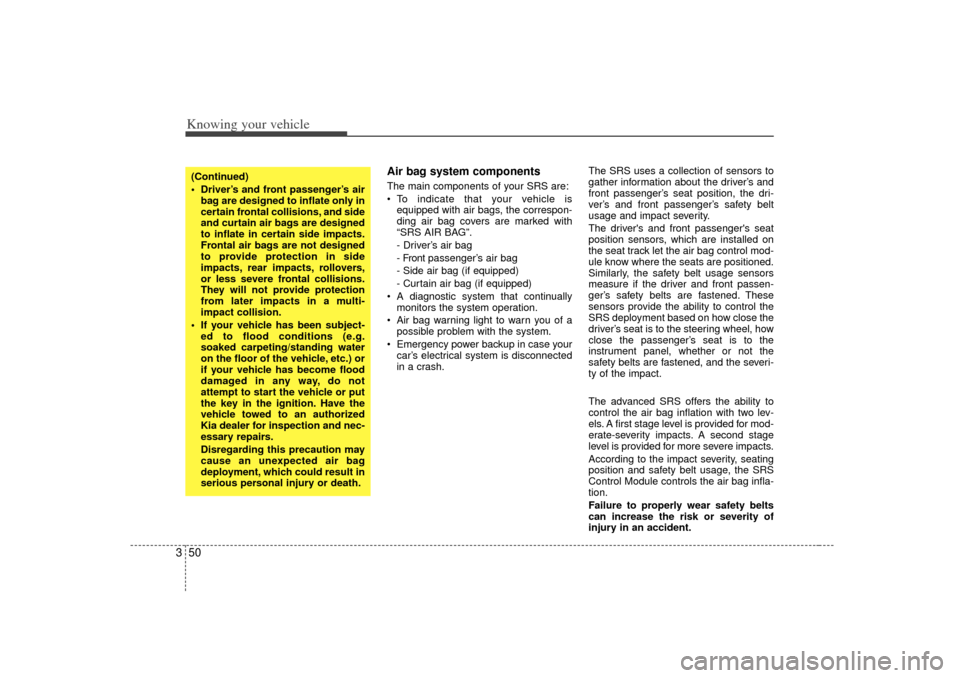
Knowing your vehicle50
3
Air bag system components The main components of your SRS are:
To indicate that your vehicle is
equipped with air bags, the correspon-
ding air bag covers are marked with
“SRS AIR BAG”.
- Driver’ s air bag
- Front passenger’ s air bag
- Side air bag (if equipped)
- Curtain air bag (if equipped)
A diagnostic system that continually
monitors the system operation.
Air bag warning light to warn you of a
possible problem with the system.
Emergency power backup in case your
car’ s electrical system is disconnected
in a crash. The SRS uses a collection of sensors to
gather information about the driver
’s and
front passenger’ s seat position, the dri-
ver ’s and front passenger’ s safety belt
usage and impact severity.
The driver's and front passenger's seat
position sensors, which are installed on
the seat track let the air bag control mod-
ule know where the seats are positioned.
Similarly, the safety belt usage sensors
measure if the driver and front passen-
ger’ s safety belts are fastened. These
sensors provide the ability to control the
SRS deployment based on how close the
driver’ s seat is to the steering wheel, how
close the passenger’ s seat is to the
instrument panel, whether or not the
safety belts are fastened, and the severi-
ty of the impact.
The advanced SRS offers the ability to
control the air bag inflation with two lev-
els. A first stage level is provided for mod-
erate-severity impacts. A second stage
level is provided for more severe impacts.
According to the impact severity, seating
position and safety belt usage, the SRS
Control Module controls the air bag infla-
tion.
Failure to properly wear safety belts
can increase the risk or severity of
injury in an accident.
(Continued)
Driver’s and front passenger’s air bag are designed to inflate only in
certain frontal collisions, and side
and curtain air bags are designed
to inflate in certain side impacts.
Frontal air bags are not designed
to provide protection in side
impacts, rear impacts, rollovers,
or less severe frontal collisions.
They will not provide protection
from later impacts in a multi-
impact collision.
If your vehicle has been subject- ed to flood conditions (e.g.
soaked carpeting/standing water
on the floor of the vehicle, etc.) or
if your vehicle has become flood
damaged in any way, do not
attempt to start the vehicle or put
the key in the ignition. Have the
vehicle towed to an authorized
Kia dealer for inspection and nec-
essary repairs.
Disregarding this precaution may
cause an unexpected air bag
deployment, which could result in
serious personal injury or death.
Page 60 of 294
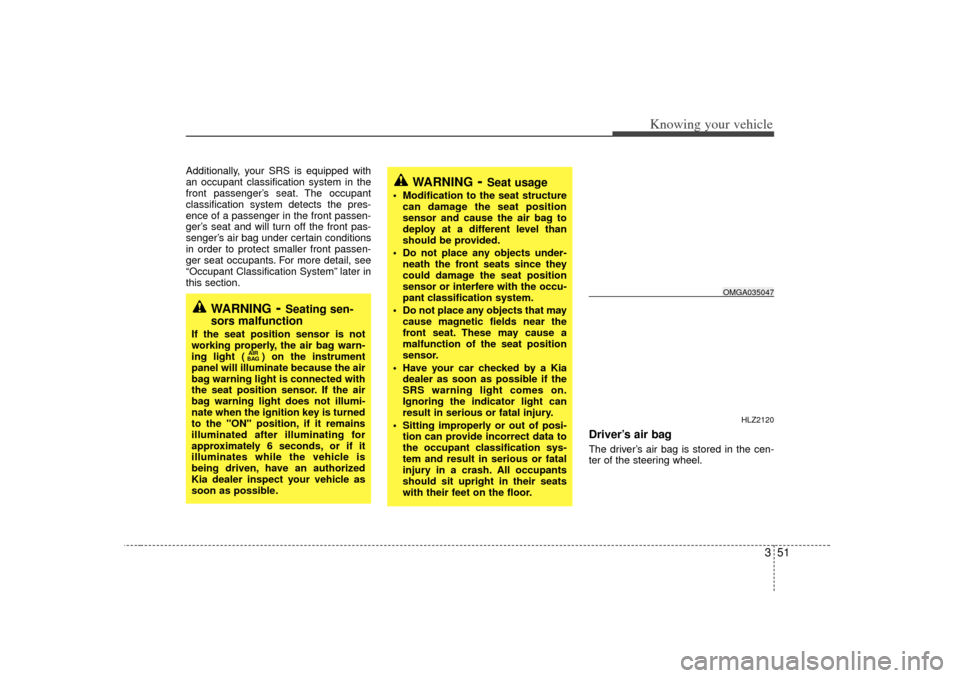
351
Knowing your vehicle
Additionally, your SRS is equipped with
an occupant classification system in the
front passenger’s seat. The occupant
classification system detects the pres-
ence of a passenger in the front passen-
ger’ s seat and will turn off the front pas-
senger’ s air bag under certain conditions
in order to protect smaller front passen-
ger seat occupants. For more detail, see
“Occupant Classification System” later in
this section.
Driver’s air bag The driver’ s air bag is stored in the cen-
ter of the steering wheel.
WARNING
- Seating sen-
sors malfunction
If the seat position sensor is not
working properly, the air bag warn-
ing light ( ) on the instrument
panel will illuminate because the air
bag warning light is connected with
the seat position sensor. If the air
bag warning light does not illumi-
nate when the ignition key is turned
to the "ON" position, if it remains
illuminated after illuminating for
approximately 6 seconds, or if it
illuminates while the vehicle is
being driven, have an authorized
Kia dealer inspect your vehicle as
soon as possible.
AIR
BAG
WARNING
- Seat usage
Modification to the seat structure
can damage the seat position
sensor and cause the air bag to
deploy at a different level than
should be provided.
Do not place any objects under- neath the front seats since they
could damage the seat position
sensor or interfere with the occu-
pant classification system.
Do not place any objects that may cause magnetic fields near the
front seat. These may cause a
malfunction of the seat position
sensor.
Have your car checked by a Kia dealer as soon as possible if the
SRS warning light comes on.
Ignoring the indicator light can
result in serious or fatal injury.
Sitting improperly or out of posi- tion can provide incorrect data to
the occupant classification sys-
tem and result in serious or fatal
injury in a crash. All occupants
should sit upright in their seats
with their feet on the floor.
HLZ2120
OMGA035047
Page 66 of 294
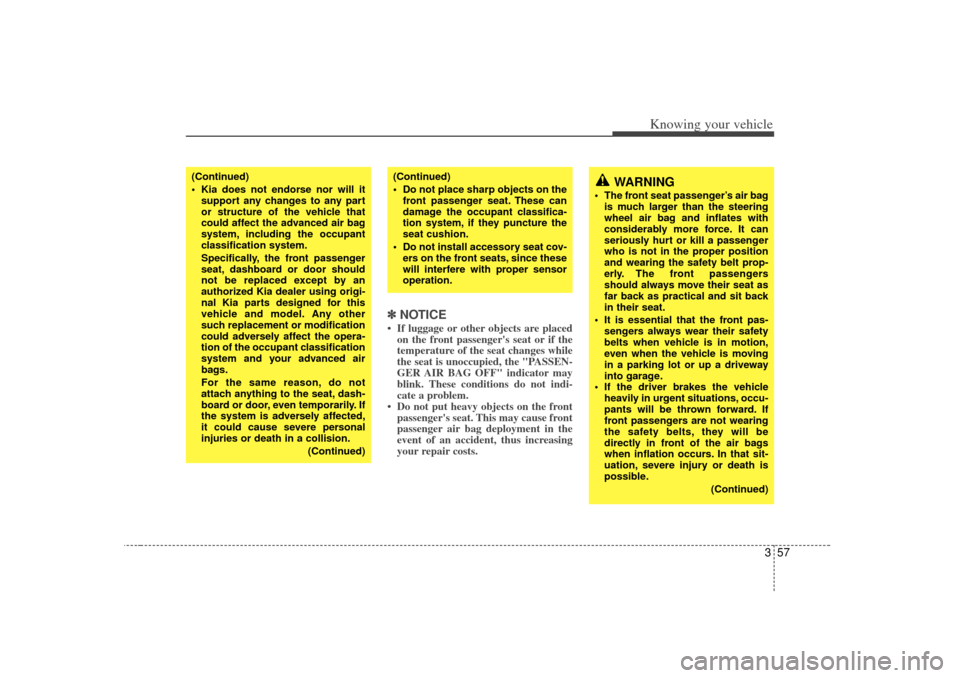
357
Knowing your vehicle
✽
✽NOTICE• If luggage or other objects are placed
on the front passenger's seat or if the
temperature of the seat changes while
the seat is unoccupied, the "PASSEN-
GER AIR BAG OFF" indicator may
blink. These conditions do not indi-
cate a problem.
• Do not put heavy objects on the front passenger's seat. This may cause front
passenger air bag deployment in the
event of an accident, thus increasing
your repair costs.
(Continued)
Kia does not endorse nor will it
support any changes to any part
or structure of the vehicle that
could affect the advanced air bag
system, including the occupant
classification system.
Specifically, the front passenger
seat, dashboard or door should
not be replaced except by an
authorized Kia dealer using origi-
nal Kia parts designed for this
vehicle and model. Any other
such replacement or modification
could adversely affect the opera-
tion of the occupant classification
system and your advanced air
bags.
For the same reason, do not
attach anything to the seat, dash-
board or door, even temporarily. If
the system is adversely affected,
it could cause severe personal
injuries or death in a collision.
(Continued)
(Continued)
Do not place sharp objects on thefront passenger seat. These can
damage the occupant classifica-
tion system, if they puncture the
seat cushion.
Do not install accessory seat cov- ers on the front seats, since these
will interfere with proper sensor
operation.
WARNING
The front seat passenger’s air bagis much larger than the steering
wheel air bag and inflates with
considerably more force. It can
seriously hurt or kill a passenger
who is not in the proper position
and wearing the safety belt prop-
erly. The front passengers
should always move their seat as
far back as practical and sit back
in their seat.
It is essential that the front pas- sengers always wear their safety
belts when vehicle is in motion,
even when the vehicle is moving
in a parking lot or up a driveway
into garage.
If the driver brakes the vehicle heavily in urgent situations, occu-
pants will be thrown forward. If
front passengers are not wearing
the safety belts, they will be
directly in front of the air bags
when inflation occurs. In that sit-
uation, severe injury or death is
possible.
(Continued)
Page 69 of 294
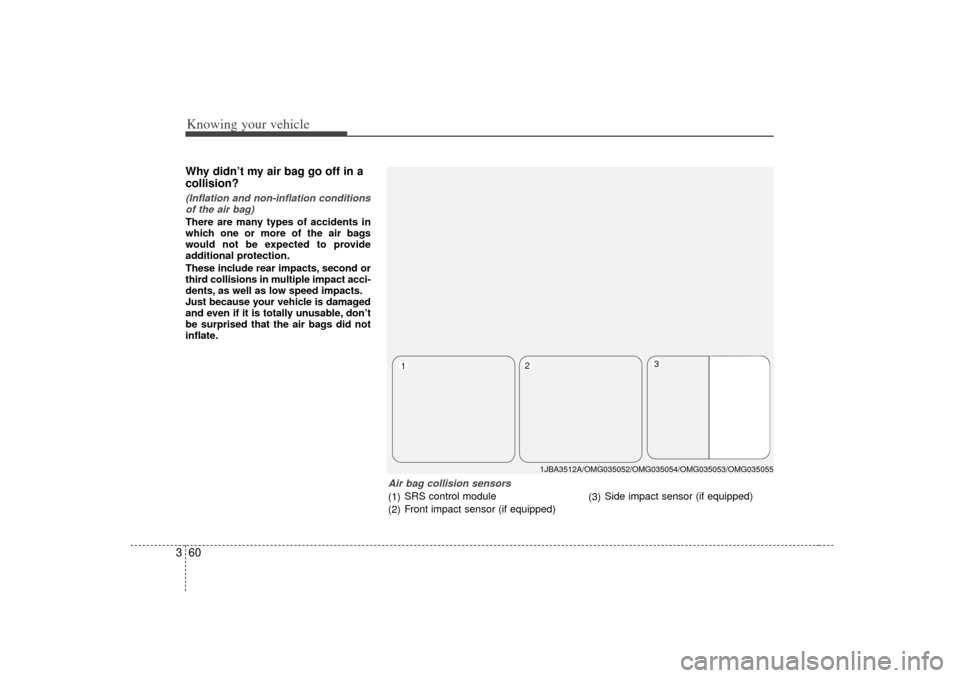
Knowing your vehicle60
3Why didn’t my air bag go off in a
collision? (Inflation and non-inflation conditions
of the air bag)There are many types of accidents in
which one or more of the air bags
would not be expected to provide
additional protection.
These include rear impacts, second or
third collisions in multiple impact acci-
dents, as well as low speed impacts.
Just because your vehicle is damaged
and even if it is totally unusable, don’t
be surprised that the air bags did not
inflate.
Air bag collision sensors(1) SRS control module
(2) Front impact sensor (if equipped) (3)
Side impact sensor (if equipped)
1JBA3512A/OMG035052/OMG035054/OMG035053/OMG035055
1
2
3
Page 70 of 294
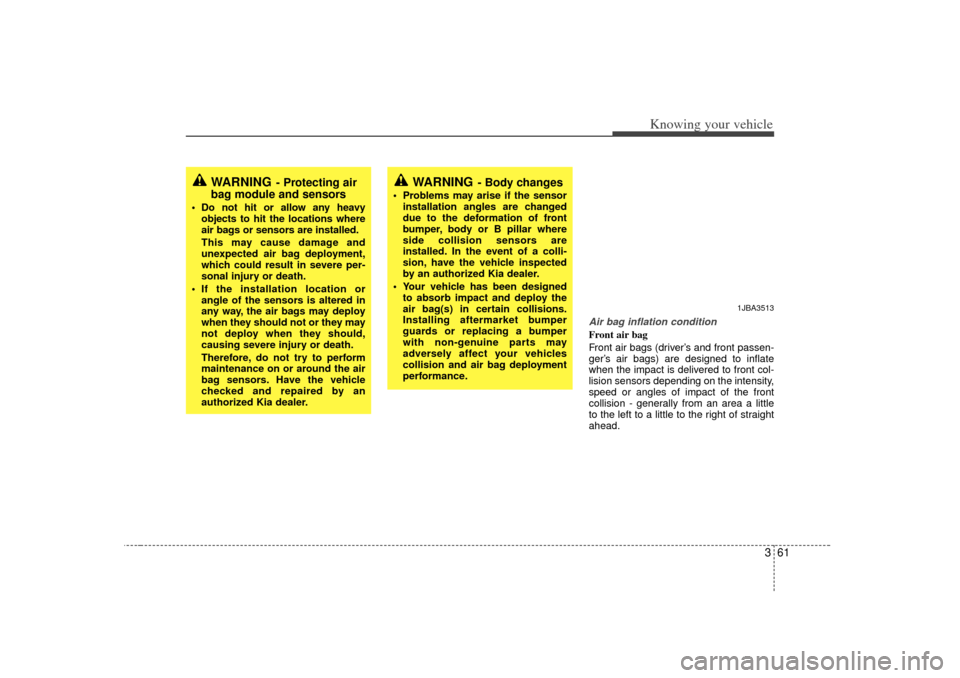
361
Knowing your vehicle
Air bag inflation conditionFront air bag
Front air bags (driver’s and front passen-
ger’ s air bags) are designed to inflate
when the impact is delivered to front col-
lision sensors depending on the intensity,
speed or angles of impact of the front
collision - generally from an area a little
to the left to a little to the right of straight
ahead.
1JBA3513
WARNING
- Protecting air
bag module and sensors
Do not hit or allow any heavy
objects to hit the locations where
air bags or sensors are installed.
This may cause damage and
unexpected air bag deployment,
which could result in severe per-
sonal injury or death.
If the installation location or angle of the sensors is altered in
any way, the air bags may deploy
when they should not or they may
not deploy when they should,
causing severe injury or death.
Therefore, do not try to perform
maintenance on or around the air
bag sensors. Have the vehicle
checked and repaired by an
authorized Kia dealer.
WARNING
- Body changes
Problems may arise if the sensorinstallation angles are changed
due to the deformation of front
bumper, body or B pillar where
side collision sensors are
installed. In the event of a colli-
sion, have the vehicle inspected
by an authorized Kia dealer.
Your vehicle has been designed to absorb impact and deploy the
air bag(s) in certain collisions.
Installing aftermarket bumper
guards or replacing a bumper
with non-genuine parts may
adversely affect your vehicles
collision and air bag deployment
performance.
Page 71 of 294
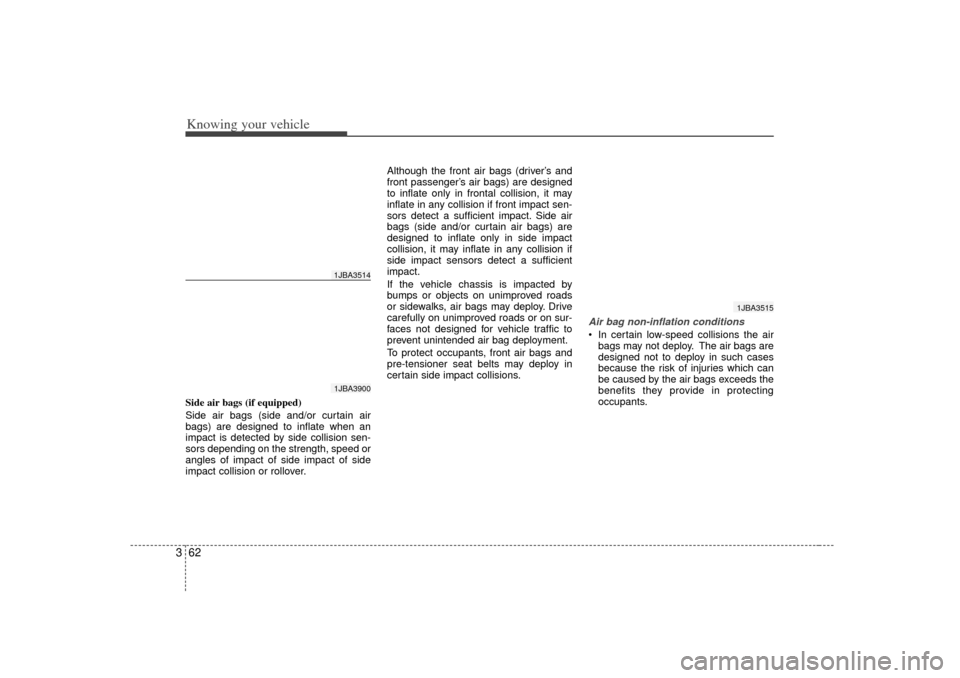
Knowing your vehicle62
3Side air bags (if equipped)
Side air bags (side and/or curtain air
bags) are designed to inflate when an
impact is detected by side collision sen-
sors depending on the strength, speed or
angles of impact of side impact of side
impact collision or rollover. Although the front air bags (driver
’s and
front passenger’ s air bags) are designed
to inflate only in frontal collision, it may
inflate in any collision if front impact sen-
sors detect a sufficient impact. Side air
bags (side and/or curtain air bags) are
designed to inflate only in side impact
collision, it may inflate in any collision if
side impact sensors detect a sufficient
impact.
If the vehicle chassis is impacted by
bumps or objects on unimproved roads
or sidewalks, air bags may deploy. Drive
carefully on unimproved roads or on sur-
faces not designed for vehicle traffic to
prevent unintended air bag deployment.
To protect occupants, front air bags and
pre-tensioner seat belts may deploy in
certain side impact collisions.
Air bag non-inflation conditions In certain low-speed collisions the air
bags may not deploy. The air bags are
designed not to deploy in such cases
because the risk of injuries which can
be caused by the air bags exceeds the
benefits they provide in protecting
occupants.
1JBA35141JBA3900
1JBA3515
Page 72 of 294
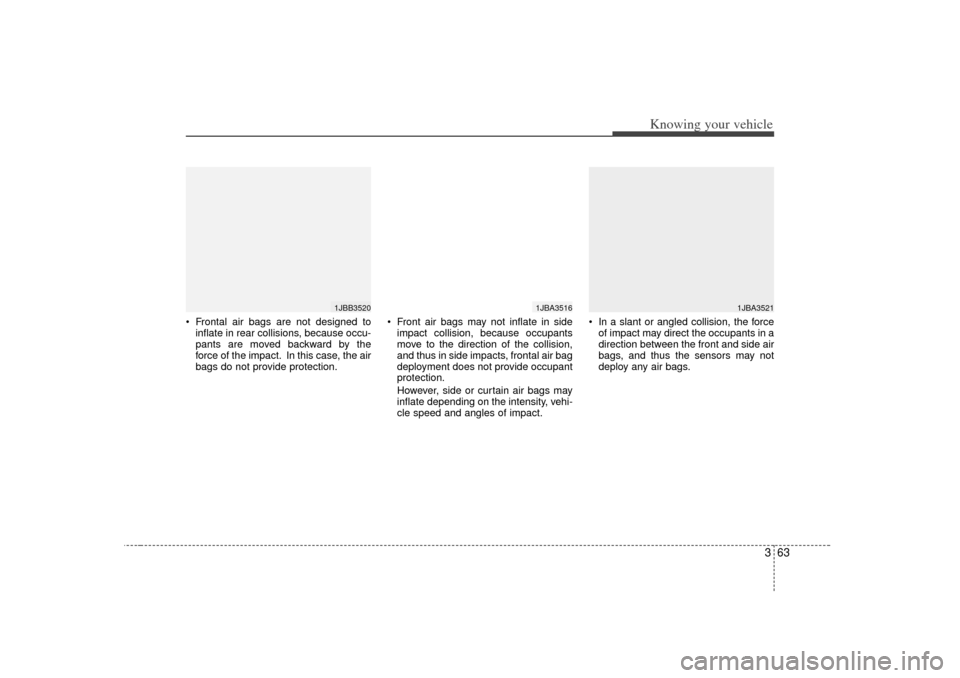
363
Knowing your vehicle
Frontal air bags are not designed to
inflate in rear collisions, because occu-
pants are moved backward by the
force of the impact. In this case, the air
bags do not provide protection.
Front air bags may not inflate in side
impact collision, because occupants
move to the direction of the collision,
and thus in side impacts, frontal air bag
deployment does not provide occupant
protection.
However, side or curtain air bags may
inflate depending on the intensity, vehi-
cle speed and angles of impact.
In a slant or angled collision, the force
of impact may direct the occupants in a
direction between the front and side air
bags, and thus the sensors may not
deploy any air bags.
1JBB3520
1JBA3516
1JBA3521
Page 73 of 294
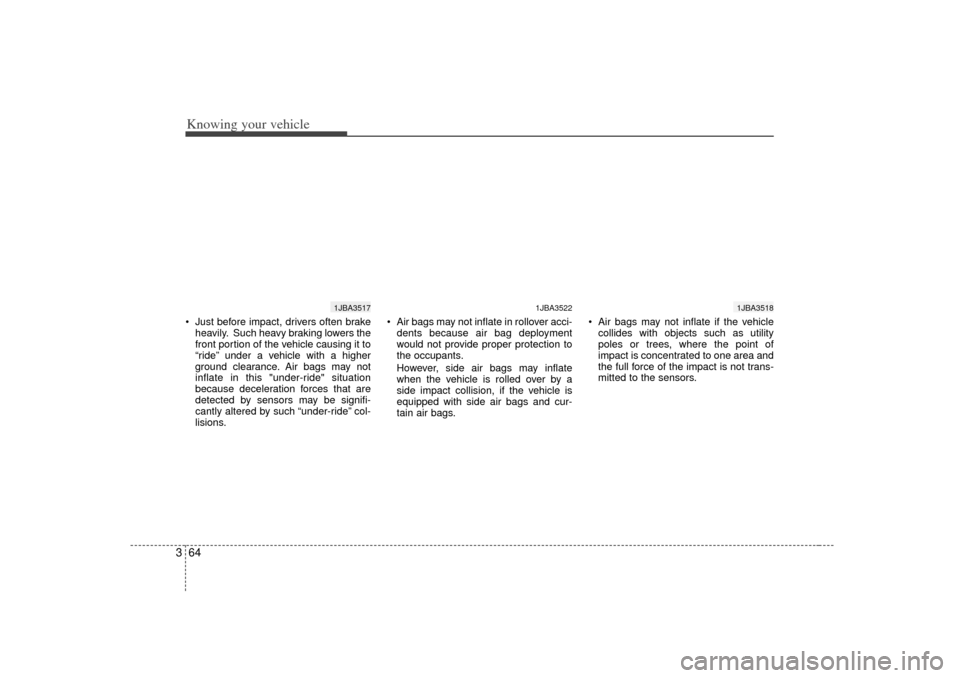
Knowing your vehicle64
3 Just before impact, drivers often brake
heavily. Such heavy braking lowers the
front portion of the vehicle causing it to
“ride” under a vehicle with a higher
ground clearance. Air bags may not
inflate in this "under-ride" situation
because deceleration forces that are
detected by sensors may be signifi-
cantly altered by such “under-ride”col-
lisions.
Air bags may not inflate in rollover acci-
dents because air bag deployment
would not provide proper protection to
the occupants.
However, side air bags may inflate
when the vehicle is rolled over by a
side impact collision, if the vehicle is
equipped with side air bags and cur-
tain air bags.
Air bags may not inflate if the vehicle
collides with objects such as utility
poles or trees, where the point of
impact is concentrated to one area and
the full force of the impact is not trans-
mitted to the sensors.
1JBA3518
1JBA3517
1JBA3522